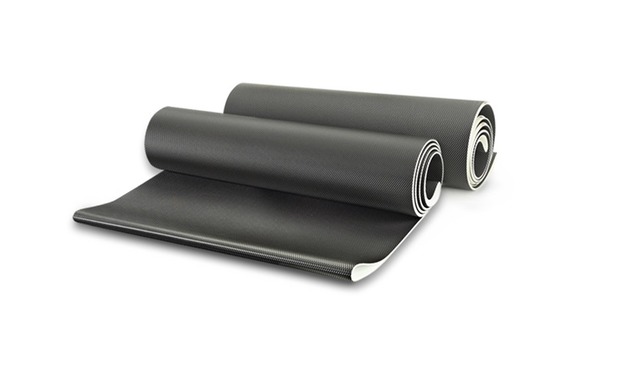Whether you’re a gymnast or a gym owner, you must be acquainted with the term Treadmill Belt. It is one of the important components of the machine that spins around the base when in use. Although the treadmill’s base is motionless, the treadmill belt moves, allowing the user to move or run. The belt is linked to a system that allows the exerciser to walk slowly, briskly, jog, or run quickly. The rate at which the belt moves is proportional to the rate at which the exerciser must walk or run.
The belt is a crucial part of a treadmill, but also the part that experiences the most wear and tears first. As a result, the belts need to be replaced regularly. The rate at which a treadmill belt wears out is determined by both the belt’s quality and the frequency with which the treadmill is operated. Another consideration is how frequently a treadmill is used. If the belt is only used for slow walking, it will most likely last longer than if it is regularly used for fast running.
Most of the Treadmill Belt Manufacturers in India also provide replacement belts. You can either purchase replacement belts directly from those manufacturers or from the brand from which you purchased the treadmill.
What Material is Used to Build Treadmill Belts?
Most belts such as rubber timing belts, and treadmill belts have a PVC top coat with some form of backing underneath to give cushioning and stability. In many situations, the PVC top will outlast the backing underneath, which means your treadmill belt may appear great but isn’t truly delivering the support it should.
Other backing materials used to build belts include cotton, polyester, poly-cotton blends, monofilament, and urethane. Cotton gives a comfortable and silent treadmill experience, but it is not quite as durable as urethane, which can last a decade or more if properly maintained. Polyester, poly-cotton mixes, and monofilament fall between these two extremes.
Type of Treadmill Belts
- Single Ply – The treadmill belt is made of a single piece of rubber.
- 2-Ply – The top side of the belt is rubber (better grade treadmills use PVC rubber), and the bottom is cotton, polyester, urethane, or monofilament.
- 4-Ply (3-Ply): Some treadmill manufacturers will add additional layers to provide better heat absorption and dispersion, as well as more “cushioning.” This can be a coating of rubber or another material.
How to check the Treadmill Belt Durability?
You can determine the durability of a treadmill belt by considering three factors – thickness, metal rollers, and lubrication.
Belt Thickness
When it comes to belt thickness, a two-ply or four-ply tread belt is more durable than a single layer. Also, thicker tread belts tend to keep quiet when in use. Most low- to mid-priced home treadmills use single-ply tracks.
Most people prefer a thicker deck because it provides greater padding and comfort for your legs and knees. A 2-ply tread belt is stretch-resistant and requires less maintenance than a 1-ply tread belt.
You won’t have to tighten the rollers as often with the high-quality 2-ply tread belt, and you’ll have a quieter and more steady workout—which is why consumers often consider tread belt thickness when purchasing a treadmill.
Metal rollers
Rollers that propel a track are another significant consideration. Rollers with large diameters reduce the load on the treadmill motor and extend belt life. A suitable roller diameter for home treadmills is approximately 2.5′.
Lubrication
Another critical feature of tread belt durability is lubrication. You need to lubricate treadmill belts to ensure smooth operation. Belts by top-quality brands require no maintenance and are typically impregnated with silicone or similar lubricant. The majority of reputed Treadmill Belt Suppliers in India integrate metallic fibers woven into belts to disperse static accumulation and eliminate health concerns.
What to do if your Treadmill Belt is Worn Out?
Fraying edges, sluggish belt movement, or a loose slipping feeling are all signs that your belt is worn out and needs maintenance. Regular maintenance and repair will assure your and other users’ safety. Look for the following things to ensure that you replace the belt as needed due to wear and tear:
Check for Slippage
A treadmill belt may slip or appear to be too loose at times. If this is the case, turn off the treadmill and remove the belt from the deck. There should be a few inches of wiggle room. If there is more than that, simply tighten the belt. Tighten the screws at the back end of the treadmill with a wrench, most likely an Allen wrench. Begin by tightening each side only half a turn. Give the belt another tug to ensure that there are only a few inches of wiggle room. Also, test the treadmill yourself at a slow speed to determine whether it’s slipping.
Lubricate the Belt
Lifting the belt by hand is a quick technique to check for sufficient lubrication, but unfastening the steel rollers is more thorough. If the wax has been dried for an extended time, there may be significant damage beneath, and it is vital to inspect it for yourself. If you’re not comfortable unscrewing anything and just want to glance around, a flashlight can help. Whatever method you use, make sure to run your hands along the deck. Is it bone dry? Is it slightly greasy or slick? If the deck is dry, you may only need to oil it for a simple remedy.
Flip the Deck
It is possible that the deck, rather than the belt, is the source of the problem. If this is the case, several treadmill decks are designed to be flipped over for increased use. While this is not always the case, check the documentation for your specific treadmill to determine if flipping the deck can extend the life of your treadmill. A damaged deck, on the other hand, will render it unusable, and flipping will be futile.
Want a treadmill belt or need to replace the old one? DKT Engineering Enterprises is a leading treadmill belt manufacturer and exporter in India. We also manufacture PVC Conveyor Belt, Rubber Timing Belt, PU Conveyor Belt, and more. Contact us now to discuss your requirements.


